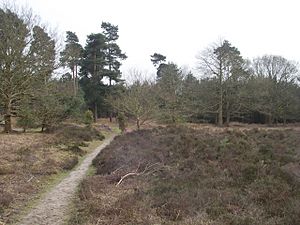Blaxhall Common facts for kids
| Site of Special Scientific Interest | |
 |
|
| Area of Search | Suffolk |
|---|---|
| Coordinates | 52°09′18″N 1°28′41″E / 52.155°N 1.478°E |
| Interest | Biological |
| Area | 45.9 hectares (0.46 km2; 0.18 sq mi) |
| Notification | 1987 |
| Location map | Magic Map |
Blaxhall Common is a fantastic nature reserve located in Blaxhall, a village in Suffolk, England. It's owned by the Blaxhall Parish Council and looked after by the Suffolk Wildlife Trust. This special place is known as a Site of Special Scientific Interest (SSSI) called Blaxhall Heath. This means it's super important for its unique plants and animals.
The common is also part of the Sandlings Special Protection Area, which helps protect wild birds. Plus, it's within the beautiful Suffolk Coast and Heaths Area of Outstanding Natural Beauty. You can even find an ancient Bronze Age burial mound here, which is a protected Scheduled monument.
Where is Blaxhall Common Located?
Blaxhall Common sits on the Suffolk Sandlings. This is a sandy area along the Suffolk coast. Long ago, this whole area was covered in lowland heathland. Today, much of that heathland is gone, but places like Blaxhall Common still survive.
The common is about 1 mile (1.6 km) east of Blaxhall village. It's also 2 miles (3.2 km) southwest of Snape. You can find it along the B1069 road. It's a great spot to visit if you're exploring the Suffolk Coast and Heaths area.
Amazing Plants and Wildlife
Blaxhall Heath is mostly covered in heather plants. It's a mix of heather and grassy areas. This creates different homes for many creatures.
One exciting success story here is the Silver-studded blue butterfly. These beautiful butterflies were brought back to the site in 2007. You might also spot cool birds like the nightjar, woodlark, and tree pipit. Reptiles like the common lizard and the adder (a type of snake) also live here. Look closely, and you might see colonies of solitary bees and even ant-lions!
To keep the heath healthy, people cut back some plants. This helps stop unwanted plants from taking over. They also use Hebridean sheep and Exmoor ponies to help manage the land. These animals graze and keep the vegetation in check. There's a car park managed by the Suffolk Wildlife Trust, making it easy for visitors to explore this special reserve.
Discovering Ancient History
Blaxhall Common holds some cool secrets from the past. Along its southern edge, you can see an ancient boundary bank. This old earthwork is very well preserved.
In the northern part of the heath, there's a Bronze Age bowl barrow. This is a type of burial mound from thousands of years ago. It stands about 1.2 meters (4 feet) tall. This barrow is a Scheduled monument, meaning it's protected because of its historical importance. The common also has signs of Iron Age settlements. You can even find a wide World War II anti-glider ditch here. This ditch now provides homes for solitary bees and lizards!

